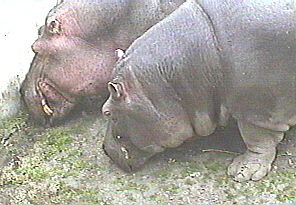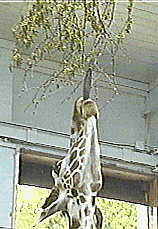 back
back The Large Mammal house currently houses Hippopotamus, Warthogs, Giraffes and Elephants.

Metata and Kibibi (pronounced Shi Bee Bee), the warthogs, are recent additions to the zoo. They are sisters. Metata means "trouble" in Swahili and her job as the eldest is to be on the lookout for trouble when the two are feeding. Kibibi means "beautiful fat girl" in the Runyankore language of Uganda.

These hungry hippos sure like to eat the grass in their compound. No need for lawnmowers here. These heavy favorites of many a zoo visitor are quite slow and awkward on land, yet graceful in the water.
Hippopotamus, which in Greek means "river horse", is actually not related to the horse at all. This amphibious mammal can stay submerged for as long as 6 minutes. Numerous aquatic adaptations are evident. Look for webbed toes, closeable nostrils and the small ears that can press close to the head.
In the wild, hippo herds pass the day lolling in the muddy waters of rivers. When exposed to the hot, tropical sun, the skin pores secrete a thin reddish mucous as a protective coating. This led to the myth that hippos sweat blood. At night hippos leave the water to consume some 70 kg of land grasses, cutting it with their long, scythe-like canine teeth.
 Giraffes
GiraffesThere are three giraffes in the large mammal house. Mason, 3 years old, was born at the Calgary Zoo. Carrie, also 3, came from the Indianapolis Zoo to complete the breeding group. Neither will be full grown until they are 5 years old. Mardi is 6 years old and fully grown (18 feet tall). Carrie is currently pregnant and is expected to give birth towards the end of this year.
 In the wild, giraffes spend about 18
hours a day foraging for food using their long tongues to strip
branches of leaves. Being the tallest of all mammals at 5 ½ metres, giraffes
use their height and 30 - 45 cm tongue to strip leaves off even
the tallest acacia trees, thus reducing competition from other
herbivores.
In the wild, giraffes spend about 18
hours a day foraging for food using their long tongues to strip
branches of leaves. Being the tallest of all mammals at 5 ½ metres, giraffes
use their height and 30 - 45 cm tongue to strip leaves off even
the tallest acacia trees, thus reducing competition from other
herbivores.
Giraffes have few enemies and are able to defend themselves with powerful
blows from their front legs. Even with its long neck, giraffes
still have only 7 neck vertebrae, the same number as most mammals,
including man.
 Elephants
ElephantsRanked with primates and dolphins in terms of brain complexity, elephants are the most intelligent of the four footed animals. Their most distinctive feature, the trunk, contains over 40,000 muscles and is used to feed, dust, bathe, smell, breath and trumpet.
There are 4 elephants at the
Calgary Zoo. One male is kept to himself and 3 females live
together. One of the females is Rani (Maharani), who was born at
the Calgary Zoo in 1990 to Kamala, the matriarch of the herd.  Kamala also
does a little painting in her spare time. Swarna, the third female,
acted as a midwife to Kamala and as playmate and babysitter to Rani.
In the wild, related females and their offspring form the basic family
unit in elephant society. Adult males associate only briefly with these
matriarchal herds for breeding. After a 22 month gestation, a baby
elephant is born into the protective and loving care of a female group.
All family members actively participate in rearing, discipline
and daycare services to assist the new mother.
Kamala also
does a little painting in her spare time. Swarna, the third female,
acted as a midwife to Kamala and as playmate and babysitter to Rani.
In the wild, related females and their offspring form the basic family
unit in elephant society. Adult males associate only briefly with these
matriarchal herds for breeding. After a 22 month gestation, a baby
elephant is born into the protective and loving care of a female group.
All family members actively participate in rearing, discipline
and daycare services to assist the new mother.
 A single days diet for one elephant may
consist of 150 kg of leaves, fruits, shrubs, grass and bark.
Elephants depend on large tracts of forest for their food supply. With
the rapid clearing of Asian forests for timber and farmland, the total
number of wild elephants continues to decline. Zoos and national
parks will be the elephants last refuge.
A single days diet for one elephant may
consist of 150 kg of leaves, fruits, shrubs, grass and bark.
Elephants depend on large tracts of forest for their food supply. With
the rapid clearing of Asian forests for timber and farmland, the total
number of wild elephants continues to decline. Zoos and national
parks will be the elephants last refuge.
The elephants go through regular fitness and examination routines daily. This keeps them in peek condition and allows the keepers to look for any problems.
96-11-03
![]() Return to my Homepage
Return to my Homepage
 Return to GeoCities
SiliconValley
Return to GeoCities
SiliconValley